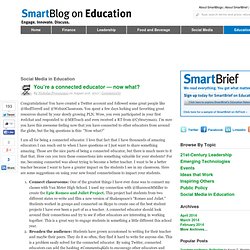

Flip This: Bloom’s Taxonomy Should Start with Creating. Teaching Strategies Chris Davis, Powerful Learning Practice LLC By Shelley Wright I think the revised Bloom’s Taxonomy is wrong.

I know this statement sounds heretical in the realms of education, but I think this is something we should rethink, especially since it is so widely taught to pre-service teachers. I agree that the taxonomy accurately classifies various types of cognitive thinking skills. Conceived in 1956 by a group of educators chaired by Benjamin Bloom, the taxonomy classifies skills from least to most complex. Many teachers in many classrooms spend the majority of their time in the basement of the taxonomy, never really addressing or developing the higher order thinking skills that kids need to develop.
Rather than starting with knowledge, we start with creating, and eventually discern the knowledge that we need from it. Here’s what I propose: we flip Bloom’s taxonomy. Creating at the Forefront In media studies we often look at the creation of print and digital advertisements. You’re a connected educator, now what? SmartBlogs. Congratulations!

You have created a Twitter account and followed some great people like @ShellTerrell and @Web20Classroom. You spent a few days lurking and favoriting great resources shared by your slowly growing PLN. Wow, you even participated in your first #edchat and responded to @MBTeach and even received a RT from @Cybraryman1. I’m sure you have this awesome feeling now that you have connected to other educators from around the globe, but the big questions is this: “Now what?” I am all for being a connected educator. Connect classrooms: One of the greatest things I have ever done was to connect my classes with Van Meter High School.
These are just a few ways that a connected educator can use their connections to impact their classrooms. Nicholas Provenzano is a high-school English teacher and a technology-curriculum specialist for the Grosse Pointe Public School System in Michigan. Creating a MiniMOOC with Verena Roberts. Marc Prensky. Web based lesson. Interactive Bloom's Digital Taxonomy Pyramid. January 2011. I just saw a Tweet asking for tips on helping students to get organized, so I decided to write some tips up.

I am a very organized person (type A personality and was an engineer for ten years) and I used to teach organizational skills to other employees at one of my jobs. There are a ton of different organizational methods out there, but it is actually pretty easy to be organized and stay that way using some free tools. I use a variety of tools to keep myself organized and share them with other teachers and with my students. I have some links below to other articles I've written that are similar in nature, so please read those too.
The first thing that is important is to decide what tools you are more comfortable with: paper or electronic. The trick to being organized is to always use your system and not deviate from it. Electronic organizing tools can be helpful because they can remind you of due dates, meetings, etc. through text messages, emails, and on-screen alerts. 1. Bloom's Digital Taxonomy. Learning 2.0. Strengthening connected online communities of practice in education. Connected Educator. 21st Century Technology. TEDxSydney - Professor Hugh Durrant-Whyte. Gamestar Mechanic. Games: Authorware. BLC10 - Keynote - Resnick. John Cleese on Creativity.
SocialEdCon at Learning 2.0 (virtual) Classroom 2.0.